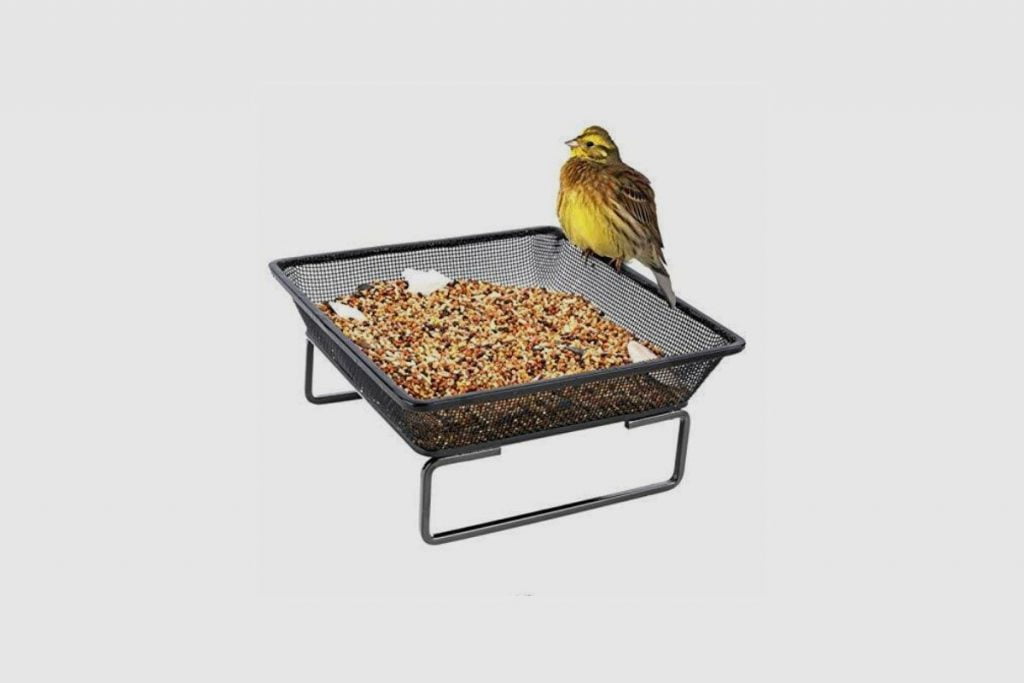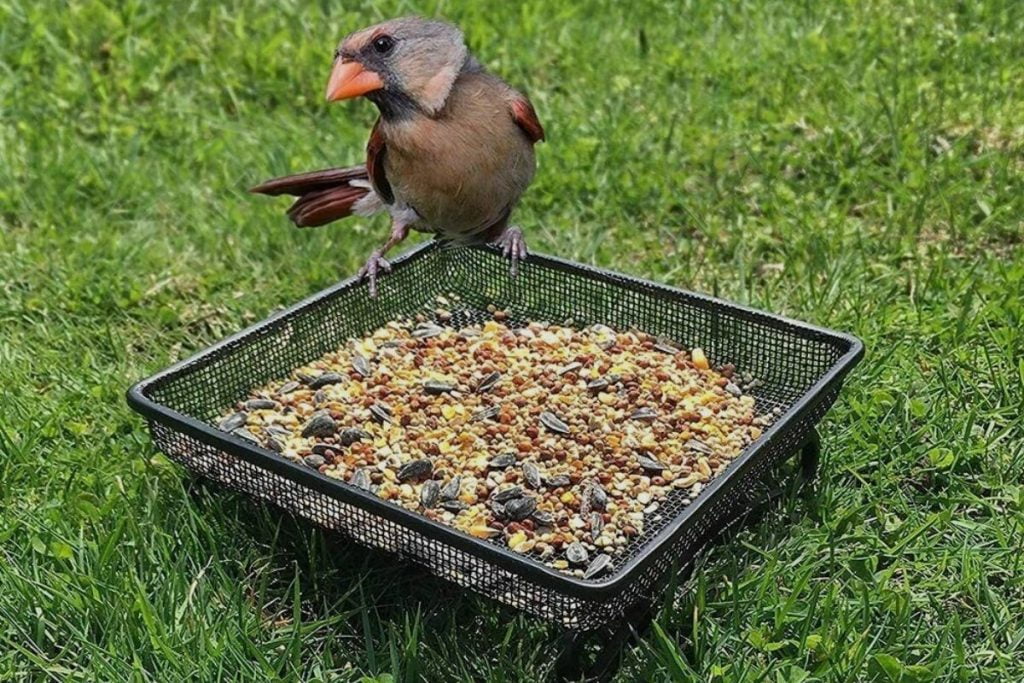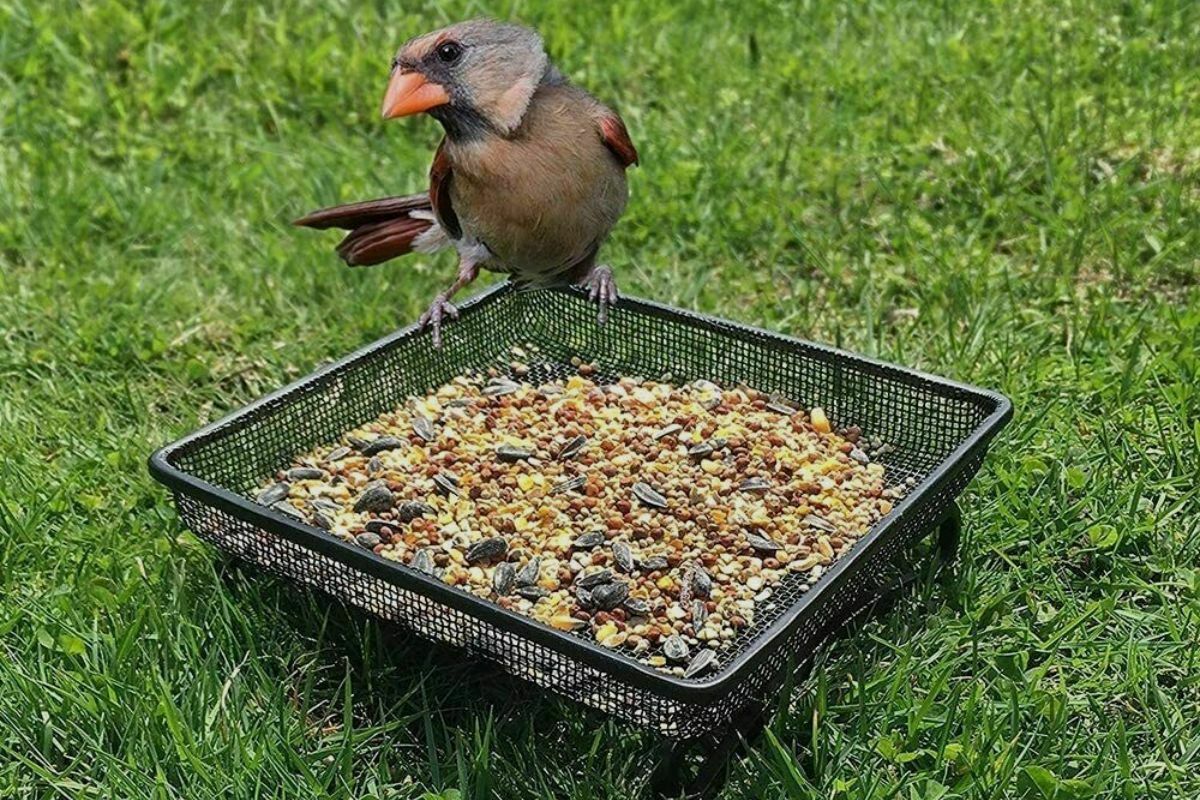Bird feeders are usually put up in high places because birds can fly, and it seems a bit counterintuitive to place your bird feeders on the ground, but you might be wondering how to best encourage birds that primarily rely on the ground to forage for food.
I advise you to introduce the following to enjoy in your gardens to attract or encourage more blackbirds, song thrushes, wrens, chaffinches, dunnocks, house sparrows, and robins. For these ground-feeding birds, it is very advantageous to have food available because any temporary food shortages, which can happen at almost any time of the year and occasionally do, can be fatal. If this occurs during the breeding season, providing more food can be very beneficial, especially for the fledglings’ survival as they try to establish the next generation.
- Can you Put a Bird Feeder on the Ground?
- How to Protect Your Ground feeding Birds from Predators and Rodents
- What Am I Supposed to Feed Ground Feeding Birds?
- What are Some of the Birds that Feed on the Ground
- Types of Ground Feeders
- Some Helpful Ground bird feeder Tips
- Conclusion
- Image Gallery – Can you Put a Bird Feeder on the Ground?

Can you Put a Bird Feeder on the Ground?
It is possible to place a bird feeder on the ground, but it feels very counterproductive to put a bird feeder on the ground for birds to feed from. A bird feeder could be placed on the ground if you happen to want to fix it, clean it, or change out the feed. However, if you keep any ground-feeding birds nearby, you should also feed them.
Placing a bird feeder on the ground will only leave them exposed to predators and rodents who would intend to eat them or eat the seeds you have left out for the birds to eat
. The best place to put a bird feeder is high in the air and away from predators who may try to do them harm. However, if you have ground-feeding birds, there are a few ways you can protect them from rodents and predators and still have your ground feeders available.
How to Protect Your Ground feeding Birds from Predators and Rodents
The most difficult aspect of ground-feeding birds is keeping other animals away, such as squirrels and pigeons. To avoid this, we have a squirrel and ground feeding haven that will deter any large birds or animals, allowing your robins, thrushes, blackbirds, and wrens to feed in peace.
These metal-fitted ground bird feeders help to keep predators like cats, owls, and weasels away from our feathered friends. The guardian feeder will help provide more safety for your unwary. If you live in an area where there are a lot of cats, make sure to feed the garden birds while they are feeding. To avoid predators, always place ground bird feeders away from trees, vegetation, and fences.
Although it is possible to dispense bird food directly on the ground, doing so can attract rats, pigeons, and predators—especially if you use subpar bird seed or food
.
Make sure you only give your ground-feeding birds high-quality bird food to prevent this. This will reduce the likelihood of pests and undesirable weeds spreading throughout your garden. The best options are mixes like our Premium No Grow, No Waste, No Husk, No Mess, Robin, and Songbird, and Premium Hi Protein Robin insect mixes.
If you live in a neighbourhood with a lot of stray cats, the guardian feeder will also help to give your unwary garden birds more safety while they eat. Please be aware that it is never a good idea to place ground bird feeders close to trees, plants, or fences.

What Am I Supposed to Feed Ground Feeding Birds?
Most bird foods can be used to feed ground birds. However, I advise against planting seeds that are still covered in their husks, such as black sunflower seeds, as the husk is not easily broken down by the soil and can encourage the growth of bacteria as well as hinder other plants that are planted underneath it.
To avoid these problems, a selection of bird tables and feeding stations with feeding trays is perfect. Additionally, they restrict access for rats and mice and stop seeds from sprouting (look for a “No Grow” mix to avoid this).
Finally, remember to shuffle your ground feeders regularly. This helps to keep disease and bacteria from spreading and infecting your garden birds.
What are Some of the Birds that Feed on the Ground
Though most birds may investigate food on the ground, some birds are more committed to ground feeders than others and will feel right at home at low-feeding stations and ground bird feeders. The following common backyard species are likely to take pleasure in ground-feeding:
- Grouse and quail
- Roadrunners and anis
- Thrashers
- Ovenbirds and waterthrushes
- Starlings, mynas, and grackles
- Doves and pigeons
- Sparrows, towhees, and juncos
- Grosbeaks, cardinals, and buntings
- Larks, pipits, and wagtails
- Robins, bluebirds, and other thrushes
- Parrots
- Northern flickers
Every bird watcher would be wise to add a low feeder to their backyard buffet since so many birds are willing and able to benefit from ground bird feeders.

Types of Ground Feeders
The design of ground bird feeders isn’t particularly important because birds don’t mind if food is just strewn across a patch of bare, open ground. To provide birds with a safe ground feeding area, extra seed can be scattered under bushes, on a patio table, or on a deck. It can also spill out of hanging bird feeders to do the same.
Additional options for ground-based bird feeders include:
- A short-legged low platform or tray feeder. These feeders may or may not have internal roofs or covers to protect the seed and keep it dry.
- Open concrete pads can help contain seeds, with or without a border. A common choice for ground feeding is the floor of a garden gazebo.
- A shallow dish such as a pie tin, large plant saucer, or an old birdbath that has been set directly on the ground. This is a fantastic way to recycle cracked, warped, or chipped dishes.
- Bird food can be placed in pet food dishes or other straightforward, shallow containers. More birds that eat from the ground can fit into larger dishes.
- A sizable sunflower head is set directly on the ground so that birds can gather their seeds. This is a simple way to feed the birds sunflower seeds that you have grown at home.
- Ground bird feeders have a lot of room for creativity, and any feeder that is only a few inches off the ground can be ideal for providing birds with a snack.
Some Helpful Ground bird feeder Tips
Here are some tips that can help backyard bird watchers make the most of any ground feeding station, whether it is a dish, a tray, or just an open area.
- Consider putting a wire cage on top of the feeder or feeding area to protect the treats from larger birds or predators and to give visiting birds a safe place to eat.
- To prevent an accumulation of uneaten food that might attract rats, raccoons, mice, or other unwanted feeder pests, only provide enough food for each day’s feeding.
- If possible, rotate low feeders or ground-feeding areas to protect the turf and grass below and maintain their health. Additionally, this will keep the feeding area tidy.
Conclusion
Ground bird feeders are always around and may be a bit difficult to protect, but it is worth it to see some ground birds move around and enjoy meals during the day.
As a bird watcher, having as many birds as possible around your home must be a dream, so keeping ground feeders around will only encourage more birds to come around your home.
It is always a lot of fun to have more birds around you, so getting or making a ground feeder should be a no-brainer.
Image Gallery – Can you Put a Bird Feeder on the Ground?




References: Bird Feeders.
